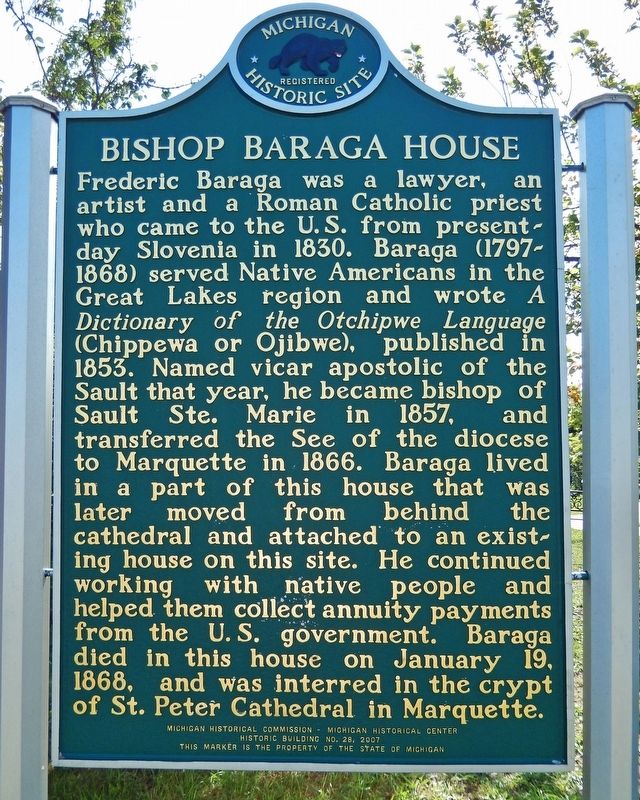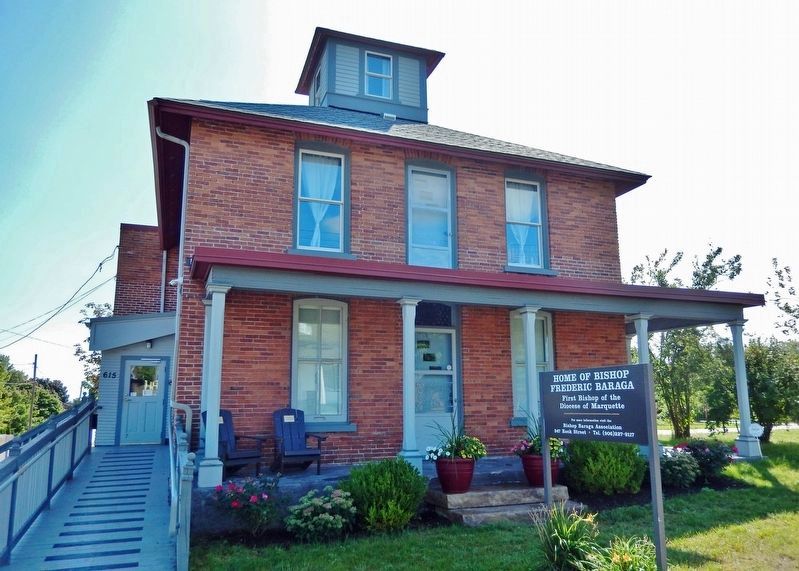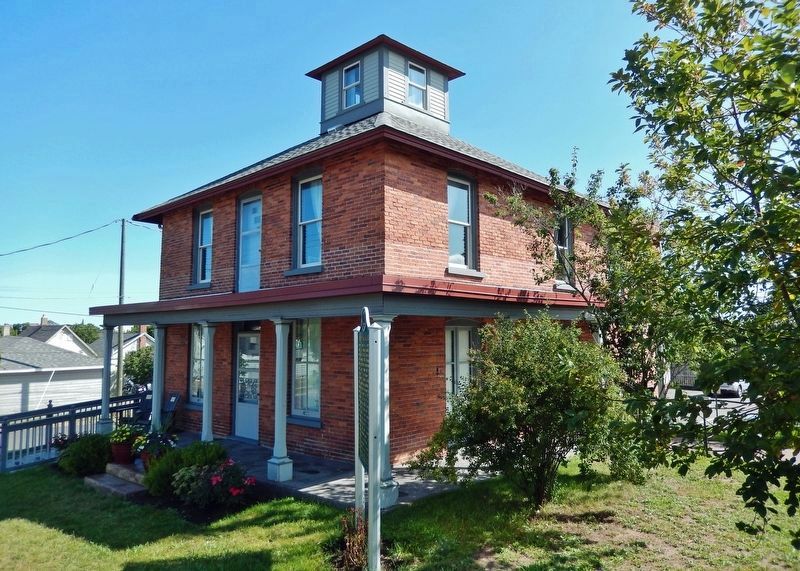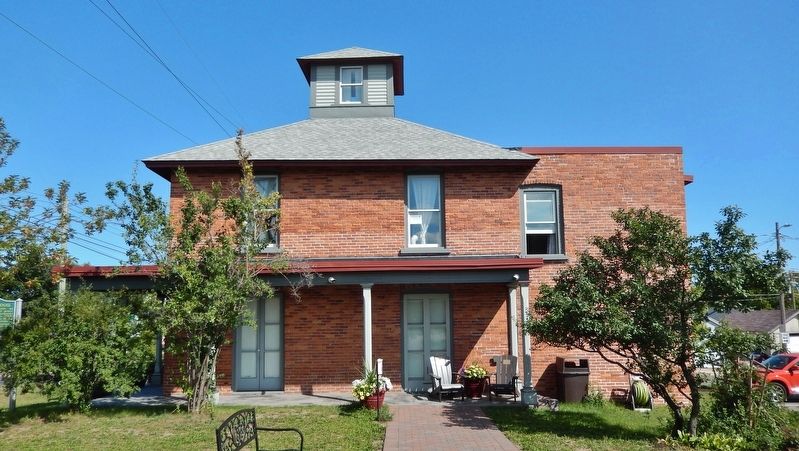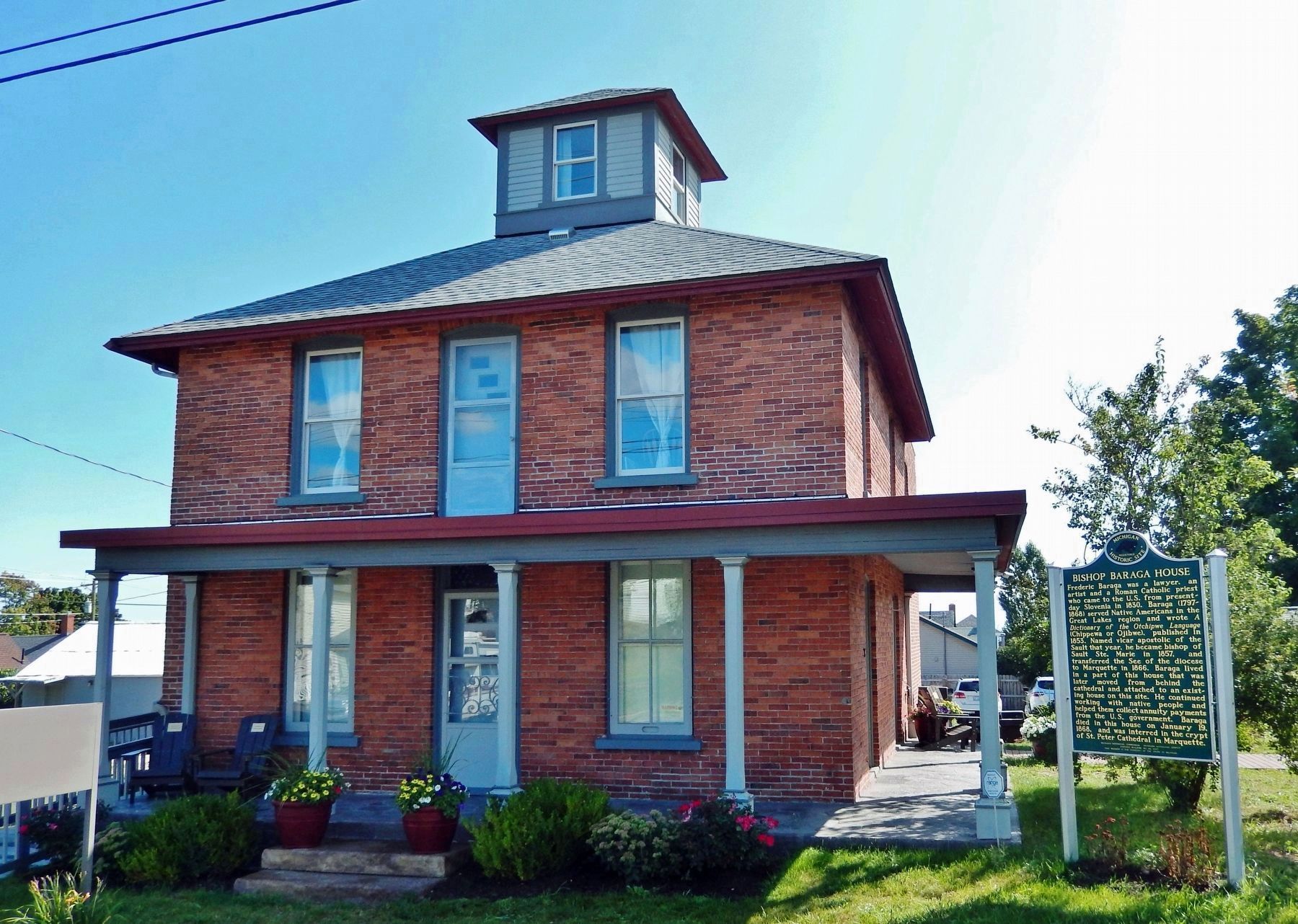Marquette in Marquette County, Michigan — The American Midwest (Great Lakes)
Bishop Baraga House
Frederic Baraga was a lawyer, an artist and a Roman Catholic priest who came to the U.S. from present-day Slovenia in 1830. Baraga (1797-1868) served Native Americans in the Great Lakes region and wrote A Dictionary of the Otchipwe Language (Chippewa or Ojibwe), published in 1853. Named vicar apostolic of the Sault that year, he became bishop of Sault Ste. Marie in 1857, and transferred the See of the diocese to Marquette in 1866. Baraga lived in a part of this house that was later moved from behind the cathedral and attached to an existing house on this site. He continued working with native people and helped them collect annuity payments from the U.S. government. Baraga died in this house on January 19, 1868, and was interred in the crypt of St. Peter Cathedral in Marquette.
Erected 2007 by Michigan Historical Commission — Michigan Historical Center. (Marker Number HB28.)
Topics and series. This historical marker is listed in these topic lists: Churches & Religion • Immigration • Native Americans • Notable Buildings. In addition, it is included in the Michigan Historical Commission series list. A significant historical year for this entry is 1830.
Location. 46° 32.337′ N, 87° 23.939′ W. Marker is in Marquette , Michigan, in Marquette County. Marker is on South 4th Street just south of Mather Street, on the left when traveling south. Marker is located near the southwest corner of the subject house. Touch for map. Marker is at or near this postal address: 615 South 4th Street, Marquette MI 49855, United States of America. Touch for directions.
Other nearby markers. At least 8 other markers are within walking distance of this marker. Marquette County Courthouse (approx. ¼ mile away); Jacques Marquette (approx. ¼ mile away); Janzen House (approx. ¼ mile away); Lower Harbor Ore Dock (approx. 0.4 miles away); Marquette's Fire Bell (approx. half a mile away); Marquette Fire Department (approx. half a mile away); First Steam Railroad in Upper Peninsula (approx. half a mile away); World War II "Silent Service" Memorial (approx. 0.6 miles away). Touch for a list and map of all markers in Marquette.
More about this marker. Both sides of this marker have the same inscription.
Also see . . .
1. Venerable Frederic Baraga’s History.
Father Baraga arrived in the New World on December 31, 1830. For the next 37 years he traveled the length and breath of the Great Lakes area to minister to the Ottawa and Chippewa Indians. During the summer months, Father Baraga traveled on foot and by canoe. During the winter months, he traveled on snowshoes thus giving him the titles of “Apostle of the Lakelands” and “Snowshoe Priest.” From 1840 to his death, he ministered to the immigrants who came to the Upper Peninsula of Michigan to work in the iron and copper mines of the region.(Submitted on September 12, 2022, by Cosmos Mariner of Cape Canaveral, Florida.)
2. Frederic Baraga.
In 1852, he began to keep a diary, written in several languages (primarily German, but with English, French, Slovene, Chippewa, Latin, and Italian interspersed), preserving accounts of his missionary travels. During this time, the area experienced a population explosion, as European immigrants were attracted to work in the copper and iron mines developed near Houghton, Ontonagon, and Marquette. This presented a challenge because he had few priests and attended to immigrant miners and the Native Americans.(Submitted on September 12, 2022, by Cosmos Mariner of Cape Canaveral, Florida.)
3. The History of the Baraga House.
The Bishop Baraga House was built in 1857 behind the present day St. Peter Cathedral on Fourth Street. It had an exterior of white painted wood and was the residence for the pastor of the soon to be built church. It became the home of Bishop Baraga in 1866, when the headquarters of the Catholic Diocese of the Upper Peninsula were transferred to Marquette from Sault Ste. Marie. Frederic Baraga died in the front right room on Jan. 19, 1868. After his death, in 1869 the house was moved across the street. In late 1872, the building was moved a second time to its present location, joined at the rear to another house, and became a private residence until its purchase by the Diocese of Marquette in 1988. A sandstone brick was added to the exterior. Some changes were made to the interior room arrangement. Both the interior Italianate decor and the external brick are considered historic.(Submitted on September 12, 2022, by Cosmos Mariner of Cape Canaveral, Florida.)
Credits. This page was last revised on September 12, 2022. It was originally submitted on September 12, 2022, by Cosmos Mariner of Cape Canaveral, Florida. This page has been viewed 177 times since then and 17 times this year. Photos: 1, 2, 3, 4, 5. submitted on September 12, 2022, by Cosmos Mariner of Cape Canaveral, Florida.
